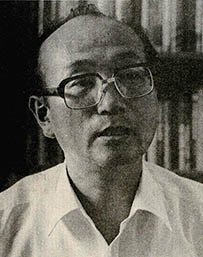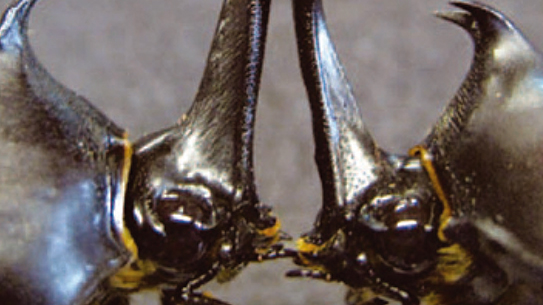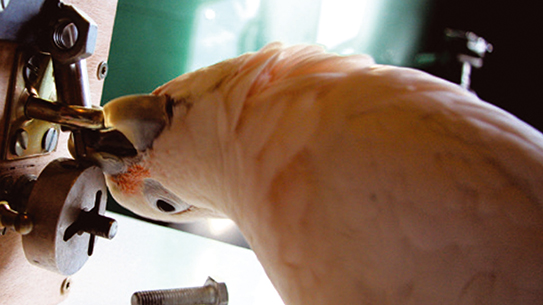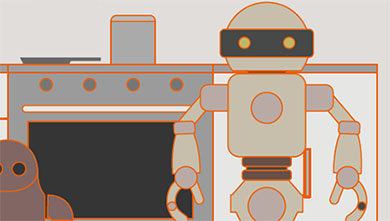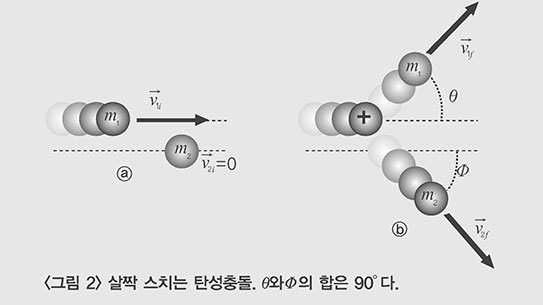인공지능계의 대가인 마빈 민스키씨 덕분에 MIT는 세계적으로 가장 중요한 로봇기술발전센터의 하나로 알려져 있다. 로봇분야를 새로운 시각에서 접근하는 컴퓨터공학과 교수인 호주출신 로드니 브룩스씨도 MIT에 있다. 브룩스씨는 아주 작은 것들을 머리속에 떠올리고 있다.
소설이나 영상매체속의 과학공상 이야기에 등장한 로봇들은 언제나 사람과 닮은 꼴이었다. 그들은 인조인간 휴머노이드들이었다. 사실 소형컴퓨터가 등장하기 전엔 로봇을 제작하는 궁극적인 목적이야말로 우리를 위해 우리의 일을 할 수 있는 기계인간들을 갖고자 하는 것이었다.
그러나 로봇에 적합한 형태가 인간이 아니라는 점은 쉽게 주장할 수 있다.
인간은 광범위하게 사용될 수 있는 팔다리와 매우 특수한 두뇌를 갖춘 다목적 작용장치다. 인간은 무거운 수레를 미는 것부터 심포니를 작곡하기까지, 나무를 베어 쓰러뜨리는 것부터 파일카드를 알파벳순서로 정리하기까지 똑같은 두뇌와 같은 근육들의 집합으로 참으로 많은 종류의 일을 수행하도록 설계되었다.
이것은 결과적으로는 인간에게 있어 크나큰 단점이다. 생활상의 위급한 상황들은 사람으로 하여금 그들의 모든 시간과 기가 막히도록 범용성있는 신체를 전문적인 일에만 활용하도록 한다. 어떤 때는 두뇌의 너무 적은 활용으로 머리를 쇠퇴시키는 작업에만 몰두해야 한다.
또 혹은 자신의 희망이나 필요에 의해 한가지 목적으로만 두뇌를 이용하고 근육을 퇴화시켜 몸이 연약해지도록 하기도 한다. 거의 대부분의 경우 사람들은 몇가지 일은 매우 잘 할 수 있도록 발전하지만 또 다른 분야에서는 심할 정도로 '불구자'가 되어버리고 만다.
만일 우리가 특별한 일을 수행할 기계장치를 원한다면 무엇때문에 부탁하지도 않을 일까지 다양하게 수행할, 범용성있는 구조체를 개발할 필요가 있는 것인가? 범용성있는 구조체를 만들려면 많은 복잡하고 어려운 문제들을 접해야 하며 현실적으로 아직은 멀었다. 그러나 특수한 일만을 수행할 특수구조체의 개발을 진행시키는 것은 상대적으로 쉬운 작업이다.
따라서 우리가 "산업용 로봇"이라고 부르는 것들은 컴퓨터기계장치들이다. 1970년대 중반에 개발된 마이크로칩 반도체는 인간의 외형은 아니지만 컴퓨터로 작동되는 팔이나 레버 모양의 값싸고 신뢰성 있으며, 특수목적에 이용되는 산업용 로봇 제작을 가능케하여 한정된 다양한 동작으로 전문화된 작업을 반복적으로 수행토록 하였다. 이들 컴퓨터 레버들은, 과다한 전문성으로 가득한 뇌로부터 명령받는 인간의 팔보다도 훨씬 일관성있게 효과적으로 작업을 수행한다. 게다가 로봇은 지치거나 지루해하는 법도 전혀 없다.
물론 그러한 로봇들은 시간이 지나면서 더욱 실용성있고 다양한 일을 할 수 있도록 보다 복잡하게 만들어질 것이다. 더욱 높은 범용성을 추구함은 억제할 수 없는 경향이다. 사실 우리가 로봇을 인조인간처럼 만드는데 노력해야 하는 이유는 적어도 두가지가 있다.
첫째, 인체에 적절하도록 설계된 방대한 기술은 이미 개발돼 있다. 인체가 특정한 식으로 뻗고 굽히듯이, 또한 팔과 다리와 손가락이 특정한 규격이듯이 기계들도 그러한 식으로 만들어 움직이도록 하는 것이다.
만약 로봇들이 구조적으로 인체와 같이 만들어진 휴머노이드들이라면 기존기술을 이용할 수 있게 된다. 한 기술은 사람을 위하여 또 한 기술은 로봇을 위하여라는 식으로 불필요하게 두가지 기술을 가질 필요가 없다.
둘째, 휴머노이드들은 작업과정의 동업자로서만이 아니라 친구처럼 가까운 존재로 느껴질 것이다. 이것이 휴머노이드를 만들려는 감정적인 이유일 것이다.
그러나 MIT의 브룩스씨는 또 다른 방향으로의 개발이(바람직스럽게) 시도되어야 한다고 생각한다. 그는 로봇 제작을 위한 보다 적절한 모형이 우리 인간의 신체와는 전혀 다르게 만들어진 곤충이라고 한다. 곤충은 아주 조그마한 체구에 그들의 기능이 아주 경제적으로 구조화된 유기체다. 그 종류가 수백만종에 달하는 곤충들은 각각 수백만가지의 전문성을 발휘하도록 되어 있어 생명영위의 한두가지 목적에 잘 부합되도록 만들어졌다. 전문화된 작업을 곤충처럼 수행하는 매우 작은 크기의 엄청나게 많은 소형로봇들(내가 로봇 곤충이라 생각하는)을 왜 만들지 않는 것인가?
브룩스씨는 꼬마로봇들에게 선박의 바깥표면으로부터 다닥다닥 붙은 굴 등을 떼어내는 일감을 맡길 수 있으리라고 한다. 화성의 흙을 탐험하는데도 가능하다. 심지어는 주사로 혈관속에 투입시켜 인체내부에서 수술을 할 수 있는 초소형로봇도 상상하고 있다.
여기서 개인적인 이야기 한마디를 하지 않을 수 없다. 나는 51년간 로봇에 대한 공상과학소설을 써 왔고 따라서 그 어느 과학자라도 내가 그동안 한두번 상상해 보지않은 새로운 아이디어를 제시하기란 쉽지 않을 것이다.
나는 지난 1974년에 쓴 "너는 그의 생각을 염두에 두라"는 제목의 책에서 아주 작은 로봇의 가능성을 이야기했다. 곤충을 박멸할 목적을 지니고 새처럼 빠르게 나는 작은 로봇을 생각했던 것이다. 또한 1988년에 쓴 "참, 안됐네요"라는 글에서는 혈관으로 들어가 정상적인 세포는 다치지 않은채 암세포를 박멸하는 미니로봇을 묘사한 바 있다.
아마도 그러한 로봇들이 실제로 등장하여 활동하게 되는 시점에 살고 있는 모양이다.
MIT thanks to the presence of its artificial-intelligence guru, Marvin Minsky, is one of the important centers of advance in robotics. Also at MIT is the Australian-born professor of computer science, Rodney A. Brooks, who is approaching robotics from a new angle. Brooks visualizes really small ones.
The kind of robots that have been pictured in science fiction stories, both in print and in visual media, have always resembled human beings. They have been humanoids, artificial human beings. That was indeed the whole rationale for robots in the days before miniaturized computers were invented─to have mechanical human beings who could do our work for us.
Yet it is easy to argue that human beings are not a proper model for robots. Human beings are all-purpose mechanisms, with generalized limbs and a highly specialized brain. A human being is designed to do many things from pushing a loaded wheel-barrow to composing a symphony, from chopping down a tree to alphabetizing a set of file cards─and doing it all with the same brain and the same set of muscles.
This is, indeed , a terrible drawback for the human beings since the exigencies of life usually compel a person to spend most of his time and his magnificently generalized body in becoming specialized. Often, he is compelled to do jobs that totally underuse his brain and atrophy it. Or he is compelled, by desire or necessity, to use that brain for one purpose and allow his muscles to atrophy and his body to grow soft. Almost always, he learns to do a few things very well and remains severely handicapped in other respects.
But if we want a mechanical device to do a particular job, why build a generalized structure capable of doing a wide variety of jobs it may never be asked to do? The attempt to build a generalized structure involves so many complexities and difficulties, the reality may be very far off. On the other hand, a specialized structure for the performance of a special job may be a comparatively simple task to carry through.
Thus, what we now call "industrial robots" are computerized machines. The microchip, developed in the mid-1970s, made it possible to build cheap, reliable, specialized industrial robots that look like not at all human but are essentially computerized arms, or levers, capable of going through a limited variety of motions that enable them to perform specific, repetitive tasks. They do this more uniformly and efficiently than a human arm run by an over-specialized brain can possibly do. And the robots, moreover, never get tired or bored.
Naturally, such robots are going to be made more complex with time, capable of varying their work usefully. The drive for greater generality will be irresistible. In fact, one can imagine at least two reasons why there should be an effort to make robots humanoid.
First, there is a vast technology in place already that is designed to fit the human body. Machines can be run in particular ways because the human body can reach and bend in certain ways, because arms and legs and fingers are of certain sizes, and so on. If robots can be devised that are humanoid in structure, they can use the technology that is already in existence. We won't have to have two of them─one for the human, and one for the robot.
Second, a humanoid robot is more apt to be looked upon and felt to be a friend, as well as a co-worker. This may be a strong emotional reason for the development of such things.
But Brooks of MIT feels there should also(and preferably) be development in other directions. He feels that a more appropriate model for robot development might be the insect body, which is built altogether differently from our own. Insects are economical organisms with their functioning built into tiny volumes, and, in their millions of species, they have millions of specializations that suit them to one form of life or another. Why not make a flood of tiny robots(which I think of as "robettes") designed to do specialized jobs a la insects?
Brooks suggests that small robots may be given jobs such as removing barnacles from the hulls of ships. He sees them conducting explorations on the soil of Mars. He even imagines very small robots that can be injected into a bloodstream to do surgery from within.
I must add a personal note, however, I have been writing science fiction stories about robots for 51 years, and it is not easy for any scientist to come up with an idea about robots that I haven't imagined at one time or another.
In a story I wrote in 1974 entitled "That Thou Art Mindful of Him," I discussed the possibility of tiny robots. I imagined a small bird-like robot that flew about speedily, with its task that of disposing of insects. Then, too, in a story I wrote in 1988 entitled "Too Bad," I described a miniaturized robot inside a bloodstream that killed cancer cells without harming normal ones.
Perhaps we're on the verge of actually seeing these tiny robots in action!
(c) 1990, Los Angeles Times Syndicate
이 기사의 내용이 궁금하신가요?
기사 전문을 보시려면500(500원)이 필요합니다.
1990년 12월 과학동아 정보
🎓️ 진로 추천
- 컴퓨터공학
- 기계공학
- 전자공학








